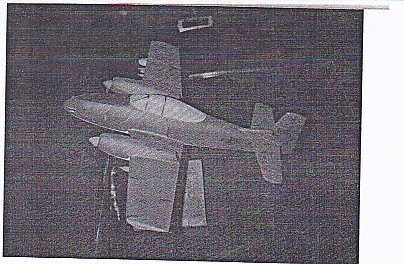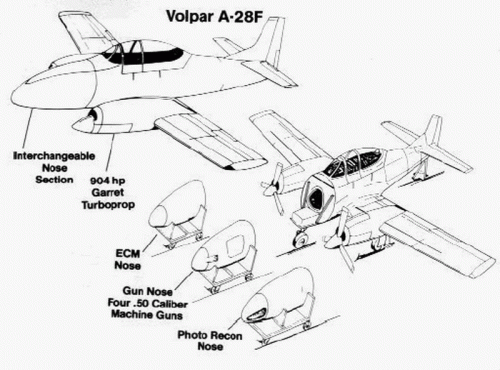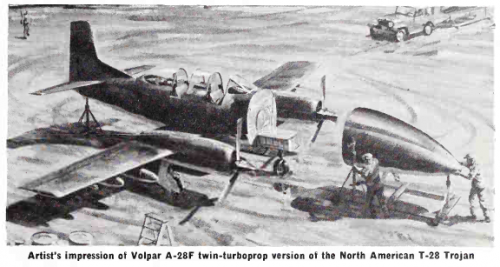You are using an out of date browser. It may not display this or other websites correctly.
You should upgrade or use an alternative browser.
You should upgrade or use an alternative browser.
North American T-28 / Volpar AT-28F
- Thread starter hesham
- Start date
famvburg
I really should change my personal text
- Joined
- 24 July 2011
- Messages
- 386
- Reaction score
- 54
I'm surprised this isn't already mentioned here other than in passing comments. Anyway, I found this photo copy in one of my folders and don't know where I got it so I can't credit it to anyone. It may be a copy out of one of several books I have. I can't locate a couple of books I have on the T-28 at the moment (in storage) and my first sighting of the AT-28F was in a book from the late '70s / early '80s, IIRC, called "Closet Cases", again IIRC. Anyway, it was a proposal by Volpar to install 2 Garrett TPE-331s of some sort and a large nose cone in place of the radial engine. I've not seen a lot of info on the proposal.
Attachments
- Joined
- 11 March 2006
- Messages
- 8,627
- Reaction score
- 3,816
famvburg said:I'm surprised this isn't already mentioned here other than in passing comments. ...
Topics merged
the Volpar AT-28F, too. The piston engine was replaced with two Garrett TPE 331-3U turboprops
of 904 hp each, using so-called "Package Power Conversions" off-the-shelf propulsion units.
The nose section, repacing the piston engine was detachable and easy and quick exchangeable.
Noses with four .50 caliber guns, ECM equipment or for photo recce were designed.
Additionally the AT-28F had six underwing hardpoints for up to 4,000 lbs.
Claimed performance were a top speed was 330 mph, service ceiling of 28,000 ft and a range
of 1,540 miles (2,800 with aux tanks of 165 gallons each).
Attachments
Jos Heyman
ACCESS: Top Secret
- Joined
- 15 February 2007
- Messages
- 597
- Reaction score
- 80
I would support AT-28F. Having said that, we have to understand that this is not an official USAF designation but rather a private one.
- Joined
- 25 June 2009
- Messages
- 14,763
- Reaction score
- 6,174
Jemiba said:The "A-28F" designation (as written in my post) was just an error during scanning those pages, sorry. :-[
It's not. It actually appears in one of the scans (from a Squadron Signal book, I believe).
It may not have been official, but it was in line with the AT-37D Dragonfly becoming the out-of-sequence A-37...
Jos Heyman
ACCESS: Top Secret
- Joined
- 15 February 2007
- Messages
- 597
- Reaction score
- 80
A-28F it is - I humbly apologise and may be I should start reading things. ;D
- Joined
- 17 October 2006
- Messages
- 2,393
- Reaction score
- 1,198
It would be an unofficial designator in any event. Quite apart from the idea of strapping two engines on a wing that was never intended to take them, and introducing 1800 shp and asymmetry to a 1400 hp single...
- Joined
- 11 March 2006
- Messages
- 8,627
- Reaction score
- 3,816
The engines are said to have been mounted at the position of the landing gear, so at least at a stronger
point of the wing.The general idea of converting a single engined design into a twin engined one, seems
to have been en vogue, the same was proposed for the Breguet Alizé
(http://www.secretprojects.co.uk/forum/index.php/topic,10679.msg100700.html#msg100700)
BTW, I still haven't found a timeframe for the A/AT-28F, not in the Squad Sig, article and not in this
thread.
point of the wing.The general idea of converting a single engined design into a twin engined one, seems
to have been en vogue, the same was proposed for the Breguet Alizé
(http://www.secretprojects.co.uk/forum/index.php/topic,10679.msg100700.html#msg100700)
BTW, I still haven't found a timeframe for the A/AT-28F, not in the Squad Sig, article and not in this
thread.
famvburg
I really should change my personal text
- Joined
- 24 July 2011
- Messages
- 386
- Reaction score
- 54
There have been several real-world single engine-to twin-engine conversions. How much redesign of the wings were involved I don't know, but I'm sure there would have been some local strengthening to the T-28's. Among real-world conversions that I know of right off were the Twin Navion, Twin Mooney and a Twin V, conversion to the Beech V-tail Bonanza. Not sure how much factory built single vs. twin engine types such as Piper and Beech have built over the years could be considered conversions or not, but it isn't that unusual.
Similar threads
-
-
North American ESO-7618 ("Jet T-28") to spec OS-141 (VTB Basic Jet Trainer)
- Started by Mark Nankivil
- Replies: 54
-
North American Rockwell VTXTS proposal (" T-2X ")
- Started by Triton
- Replies: 5
-
North American NA-148 Executive Transport (a civilian Mitchell)
- Started by Stargazer
- Replies: 18
-
Martin Model 244 USAF Trainer (NAA T-28 competitor)
- Started by Stargazer
- Replies: 5




